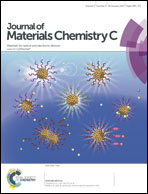Light sensing in photosensitive, flexible n-type organic thin-film transistors
Abstract
Control of the operating voltage in organic thin-film transistor (OTFT) based photosensors is a very important issue, which can effectively enhance photosensitivity by reducing the contribution of the field-effect current to the output current under darkness. In this study, we show a highly sensitive flexible organic photosensor, which is made by the use of cross-linked poly(4-vinylphenol) as a polymer dielectric layer and N,N′-ditridecyl-3,4,9,10-perylenetetracarboxylic diimide (PTCDI-C13H27) as an n-type active layer on a transparent polyethersulfone (PES) substrate, by tuning both source–drain and source–gate voltages to around the threshold voltage (Vt = 3.0 V). Interestingly, a maximum photocurrent/dark current ratio was obtained when the operating voltage was reduced to around Vt. The time-response characteristics and sensitivity of the PTCDI-C13H27-based photosensor were investigated. Considerable interest has been focused on developing a flexible in-cell remote touch screen that should comprise photosensitive OTFTs and switch OTFTs simultaneously. In this work, both switch-OTFTs and photo-OTFTs can be formed on the flexible PES substrate by use of the same fabrication process. The electrical characteristics of switch-OTFTs under bending states are discussed in terms of photoluminescence and time-resolved photoluminescence measurements, as well as quantum theory calculations.


 Please wait while we load your content...
Please wait while we load your content...